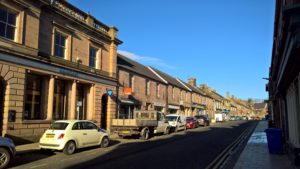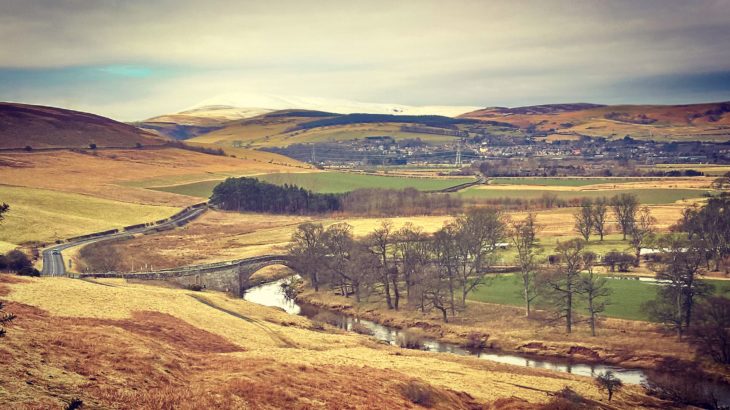On Monday, March 19th, at about 9:45, I rolled off the ferry and my wheels touched British soil. My research trip could now really get under way.  The customs officer showed zero interest in my car, full to bursting, and didn’t even notice that I left the Netherlands with a Spanish ID and entered Newcastle with a British passport. But, well, it’s all the same. Driving on the left quickly became a habit and the driver’s position on the left is only a bit awkward at intersections and motorway ramps. After about 5 hours drive on “the continent” (as the British call it) and a whole night on the ferry, I had only about one hour left to reach my destination: the small town of Wooler in the County of Northumberland.
The customs officer showed zero interest in my car, full to bursting, and didn’t even notice that I left the Netherlands with a Spanish ID and entered Newcastle with a British passport. But, well, it’s all the same. Driving on the left quickly became a habit and the driver’s position on the left is only a bit awkward at intersections and motorway ramps. After about 5 hours drive on “the continent” (as the British call it) and a whole night on the ferry, I had only about one hour left to reach my destination: the small town of Wooler in the County of Northumberland.
On the way, you could still see the remains of the snow that had fallen plentifully in the last few weeks and had now almost completely melted – except on the higher hills. I am relatively familiar with the road because my grandparents spent their retirement years in a small hamlet outside Wooler. I’m coming back – let me think just a moment – after about five years, but this time looking for a whole new perspective. Specifically, my destination is the community and meeting centre “The Cheviot Centre” where the partner organisation for my study on the “resilience of rural communities” is located: “The Glendale Gateway Trust“.
I’m coming back – let me think just a moment – after about five years, but this time looking for a whole new perspective. Specifically, my destination is the community and meeting centre “The Cheviot Centre” where the partner organisation for my study on the “resilience of rural communities” is located: “The Glendale Gateway Trust“.
Wooler is a small town (Historical Market Town) with about 1900 inhabitants in the northernmost county of England, Northumberland. Personally, I would call Wooler a biggish village. On the edge of the Northumberland National Park and at the feet of the Cheviot Hills (highest peak 815 m), it lies in what is known as the Glendale Valley. Glendale covers a relatively large part of northern Northumberland (642 km²) and is based on an earlier, now defunct, administrative entity (“Glendale Rural District” until 1974) with as many as 22 localities and approx. 6,000 people (the population statistics are not up to date).
So Wooler and Glendale are among the most peripheral and sparsely populated corners of England (fewer than 10 inhabitants / km²).
In addition to the rural character of the area, the importance of livestock farming (the number of sheep round here!) and agriculture contributes to the regional economy. The scenery round about and the location of Wooler in the valley is really beautiful.
So, back to my arrival. Just through the main door of the community centre I mentioned, my future landlady welcomed me for the ten weeks I’ll be staying. She works as a receptionist and secretary of the “Cheviot Centre”. The chief officer and the administrative assistant of the Trust invited me straight away to one of the cafés on Wooler High Street (the main street and shopping area) for a hot drink (it was 5°C).  After our first exchange and introductions, we returned to the office and they let me set up my work place and make myself comfortable there. The community centre is very busy and eagerly used by local groups (eg: senior citizens’ groups can participate in a wide variety of activities there, there are courses on all sorts of topics and for all ages, companies gather there for a monthly briefing, self-employed people and small businesses have rented office space in the building and much more).
After our first exchange and introductions, we returned to the office and they let me set up my work place and make myself comfortable there. The community centre is very busy and eagerly used by local groups (eg: senior citizens’ groups can participate in a wide variety of activities there, there are courses on all sorts of topics and for all ages, companies gather there for a monthly briefing, self-employed people and small businesses have rented office space in the building and much more).
In just five working days I have had a great number of interesting encounters. Appointments with partner organisations, advanced training in the Cheviot Centre or spontaneous visits to the office of cooperation partners and community members result in really interesting contacts that convey a sense of openness and great interest in me and my work. The topics floating around are also very varied, here are some examples: the structure and development history of the Glendale Gateway Trust, the administrative structure and tasks of local and regional government, various building projects and the great need for affordable housing in the village and in Glendale generally, the qualification of the unemployed, the future of the former and now disused primary school, the soon to come into force “Basic Data Protection Regulation” and its consequences for small organisations, the cooperation with the Northern Ireland twin town of Broughshane, the creation of a Regional Mental Health Working Group, or the diverse activities in the community centre.
 The open and attentive nature of the people I have encountered so far is a real pleasure. Regardless of their age. I am also struck by their sense of humour. Whether you can call it typical British humour or not, they usually have time for a laugh, a joke or to poke fun at the absurdity of everyday life. In particular, Brexit crops up this way every now and then. Nobody here seems to understand it completely, even though in Northumberland a majority voted for Brexit. In any case, Brexit or not, I have been given a very positive reception by the team at the “Trust” and also at home I can count myself lucky with my nice landlady and her cat.
The open and attentive nature of the people I have encountered so far is a real pleasure. Regardless of their age. I am also struck by their sense of humour. Whether you can call it typical British humour or not, they usually have time for a laugh, a joke or to poke fun at the absurdity of everyday life. In particular, Brexit crops up this way every now and then. Nobody here seems to understand it completely, even though in Northumberland a majority voted for Brexit. In any case, Brexit or not, I have been given a very positive reception by the team at the “Trust” and also at home I can count myself lucky with my nice landlady and her cat.
To top off my first week in Wooler, the sun was shining all weekend and I was able to explore the area by mountain bike and car.
I think the photos speak for themselves. The scenery is really fantastic. Northumberland is a much-loved destination among landscape and nature photographers. So yes, slowly I’m getting to feel a “sense of place” as they call it in English. In the coming weeks, I will be able to find out more about whether Wooler is one of these “special places” in rural areas. Maybe a resilient village or a resilient small town?
 For upcoming posts, I have some interesting ideas, eg: to write more about what are known as “community land trusts“. These are organisations rooted in the village community contribute to the sustainable development in the village by managing and developing their own properties and land. Their origin, their structure and their contribution to fairer and more sustainable land and village development will be the subject of an upcoming post. Might these turn out to be a resilient element of particularly adaptable villages? Stay tuned to my blog!
For upcoming posts, I have some interesting ideas, eg: to write more about what are known as “community land trusts“. These are organisations rooted in the village community contribute to the sustainable development in the village by managing and developing their own properties and land. Their origin, their structure and their contribution to fairer and more sustainable land and village development will be the subject of an upcoming post. Might these turn out to be a resilient element of particularly adaptable villages? Stay tuned to my blog!
